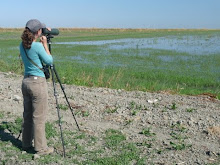 Saturday afternoon, we barreled up Ruta 9, which varied between a luxurious two-lane highway with wide shoulders as you would find the the U.S. and a narrow, bumpy, no room for mistakes road
Saturday afternoon, we barreled up Ruta 9, which varied between a luxurious two-lane highway with wide shoulders as you would find the the U.S. and a narrow, bumpy, no room for mistakes road
 We arrived in Loma Plata, a German Mennonite settlement, much after dark and encircled the dirt road town many time in search of Hotel Mora, modest and clean lodging on the outskirts of town. We checked in for a few hours of sleep before heading out at dawn. The lagoons were still and hour and a half away by dirt road.
We arrived in Loma Plata, a German Mennonite settlement, much after dark and encircled the dirt road town many time in search of Hotel Mora, modest and clean lodging on the outskirts of town. We checked in for a few hours of sleep before heading out at dawn. The lagoons were still and hour and a half away by dirt road.
 The first stop was completely dry. Not a good sign. We passed a few other would be lagoons on our way to Campo Maria, the deepest lagoon. If any of them had water, this one surely would. The property is privately owned by a German Mennonite farmer who grants people access for a small '"park entrance fee".
The first stop was completely dry. Not a good sign. We passed a few other would be lagoons on our way to Campo Maria, the deepest lagoon. If any of them had water, this one surely would. The property is privately owned by a German Mennonite farmer who grants people access for a small '"park entrance fee".
 Indeed, Campo Maria Lagoon held water…..but not much else.
Indeed, Campo Maria Lagoon held water…..but not much else.
The lagoon is a huge network and there is hardly a bird in sight on the water. From the observation tower, we spot a few stilts and yellowlegs and enjoy watching the Monk Parakeets feeding on the sand. After setting up camp we split up into pairs and explore the shore of the lagoon. We saw 3 Pluvialis (American-Golden) and a flock of 8 C. fuscicollis (White-rumps) and a lost cow. Not even the customary flamingos were calling this lagoon home.
In the evening we again watched the lagoon for signs of activity from the observation tower. We observed tons of songbird activity  (I only wish I had time to publish a list! Birder's take note this is the time of year to visit the Paraguay Chaco!) and nearing the last light, saw a flock of 25 Calidris spp. flying N to S to our east. This was good but not enough to justify staying for the week. Though lacking in shorebirds, we enjoyed nightfall as the nighthawks, nightjars and potoos made their presence known. There really is no night like a night in the
(I only wish I had time to publish a list! Birder's take note this is the time of year to visit the Paraguay Chaco!) and nearing the last light, saw a flock of 25 Calidris spp. flying N to S to our east. This was good but not enough to justify staying for the week. Though lacking in shorebirds, we enjoyed nightfall as the nighthawks, nightjars and potoos made their presence known. There really is no night like a night in the
Arriving back to camp, we
Discouraged, yet impressed by the bird life of the Chaco, we headed back to


2 comments:
Thanks for all the pics, Khara!
Did you help the cow get home? Hope you catch lot o' birds in Argentina - good luck!
Post a Comment